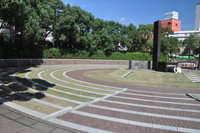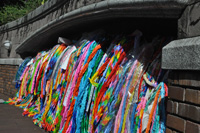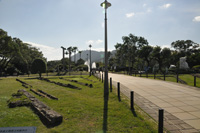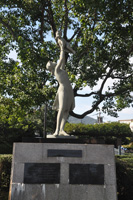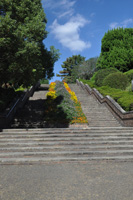 Established in 1955, and near to the hypocentre of the explosion, remnants of a concrete wall of Urakami Cathedral can still be seen. Urakami Cathedral was the grandest church in east Asia at the time. At the park's north end is the 10-meter-tall Peace Statue created by sculptor Seibou Kitamura of Nagasaki Prefecture. The statue's right hand points to the threat of nuclear weapons while the extended left hand symbolizes eternal peace. The mild face symbolizes divine grace and the gently closed eyes offer a prayer for the repose of the bomb victims' souls. The folded right leg and extended left leg signify both meditation and the initiative to stand up and rescue the people of the world. Installed in front of the statue is a black marble vault containing the names of the atomic bomb victims and survivors who died in subsequent years.
Established in 1955, and near to the hypocentre of the explosion, remnants of a concrete wall of Urakami Cathedral can still be seen. Urakami Cathedral was the grandest church in east Asia at the time. At the park's north end is the 10-meter-tall Peace Statue created by sculptor Seibou Kitamura of Nagasaki Prefecture. The statue's right hand points to the threat of nuclear weapons while the extended left hand symbolizes eternal peace. The mild face symbolizes divine grace and the gently closed eyes offer a prayer for the repose of the bomb victims' souls. The folded right leg and extended left leg signify both meditation and the initiative to stand up and rescue the people of the world. Installed in front of the statue is a black marble vault containing the names of the atomic bomb victims and survivors who died in subsequent years.
 A plaque at the nearby hypocentre gives the following account and statistics of the damage caused that day: "At 11:02 A.M., August 9, 1945 an atomic bomb exploded 500 meters above this spot. The black stone monolith marks the hypocenter. The fierce blast wind, heat rays reaching several thousand degrees and deadly radiation generated by the explosion crushed, burned, and killed everything in sight and reduced this entire area to a barren field of rubble. About one-third of Nagasaki City was destroyed and 150,000 people killed or injured and it was said at the time that this area would be devoid of vegetation for 75 years. Now, the hypocenter remains as an international peace park and a symbol of the aspiration for world harmony."
A plaque at the nearby hypocentre gives the following account and statistics of the damage caused that day: "At 11:02 A.M., August 9, 1945 an atomic bomb exploded 500 meters above this spot. The black stone monolith marks the hypocenter. The fierce blast wind, heat rays reaching several thousand degrees and deadly radiation generated by the explosion crushed, burned, and killed everything in sight and reduced this entire area to a barren field of rubble. About one-third of Nagasaki City was destroyed and 150,000 people killed or injured and it was said at the time that this area would be devoid of vegetation for 75 years. Now, the hypocenter remains as an international peace park and a symbol of the aspiration for world harmony."
War is a complex reality, and therefore possessing complex theological dimensions. The world is finite (having a beginning) and is historical. Harmony is affected by the complex realities of families, neighborhoods, national and economic interests, and in other words communities of peoples. It should be obvious, as well, that individuals have a bearing on peace.
Peace requires reasonable sacrifices, or adjustments and compromises. It requires moderation, the balancing of claims, equilibrium in individuals and among groups. Much conflict arises from a sense of unconditional freedom for oneself or community. Compromise requires the foregoing of compensation or appreciation. Sometimes we pay a hefty price to make peace. People of faith believe in a peace that allows for the possibility of an undeniable and indestructible meaningfulness. This means that people of faith can suffer the loss of immediate goods for the sake of peace. This should be contrasted with blind submission or submission to a totalitarian power. There are things we are not required to put up with. Godly people, therefore, often face a choice to enter into or avoid conflict. (Rahner, TI 22, 38-42).
 One of the most stricking contrasts between the hypocenter memorial and the peace park a few blocks away is that the central blast area has several depictions of the horror of the firestorm upon families and children, and the memorials at the peace park highlight the hope that children and families represent.
One of the most stricking contrasts between the hypocenter memorial and the peace park a few blocks away is that the central blast area has several depictions of the horror of the firestorm upon families and children, and the memorials at the peace park highlight the hope that children and families represent.
I have always wanted to visit this place but never imagined how it would move me. I have two uncles who I will never know who died in the Pacific Theater in World War II. I recognize that many are grateful that the atomic bombing of Nagasaki and Hiroshima made a quick end to the war. Nevertheless, the hypocenter left me with a feeling of desolation that can only be remedied by the hope that this kind of devastation never happen again.


